
Ingredients
BATTER
1 1/2 cups cornflakes
1 1/2 cups cold whole milk
3 large eggs
1 1/2 cups sugar
6 tablespoons (3/4 stick) plus 2 teaspoons unsalted butter
1 1/2 cups unbleached all-purpose flour
1/2 teaspoon salt
1 1/2 teaspoons baking powder
1 teaspoon vanilla extract
CORNFLAKE GANACHE
3 2/3 cups cornflakes
11/3 cups heavy cream
10 ounces Valrhona Dulcey Blond Chocolate, finely chopped
1 1/2 tablespoons unsalted butter, cut into 3 pieces and softened
3/8 teaspoon salt
 Stir, Sizzle, Bake: Recipes for Your Cast-Iron Skillet
Stir, Sizzle, Bake: Recipes for Your Cast-Iron Skillet
While you’d typically make a layer cake using “normal” circular aluminum baking pans, isn’t it nice to know you don’t need them? That you can do it with a single cast-iron skillet? A tribute to baker Liz Lorber in Atlanta, who introduced me to Hot Milk Cake and got my wheels turning, this recipe also reminds me of my father. He’s almost always on a diet, and whichever one it is, it usually forbids cereal. Sometimes he’ll say, with such longing, that all he wants is a simple bowl of cornflakes and milk—or even better, cornflakes and cream. Poor Dad! If only he wasn’t on a diet, again, I’d cut him a square of this crunchy-coated, fluffy cake.
Directions
1. Make the batter: Preheat a 10-inch cast-iron skillet on the stovetop, gradually raising the heat from low to medium. When the pan is hot, add the cornflakes and toast for about 6 minutes, shaking the pan frequently and vigorously, and watching to make sure they don’t burn. Transfer the cereal to a 5½-inch strainer.
2. Place the strainer with the toasted cornflakes in a small saucepan. Pour the cold milk over the strainer into the saucepan, so that the cereal is immersed in the milk. Cover and warm the milk over medium-low heat. Bring the mixture just below its boiling point; when you see little bubbles around the rim of the milk, remove it from the heat (this should take up to 10 minutes, but you should check your milk at 7 or 8 minutes, to be safe). Let the mixture sit, covered, for 45 minutes.
3. While the cornflakes are steeping in the milk, preheat the oven to 350ºF with a 10-inch cast-iron skillet in it.
4. In the bowl of a stand mixer fitted with the whisk, beat the eggs until foamy, starting on medium-low and increasing the speed as you go. Whisk the sugar in gradually and continue beating until the mixture is thick and glossy.
5. Remove the strainer from the milk and discard the cornflakes. Measure out 3/4 cup of the infused milk and discard the remainder. Return the reserved milk to the saucepan and add the 6 tablespoons butter. Cook over medium heat, stirring, until the butter melts.
6. In another bowl, sift together the flour, salt, and baking powder. Using a rubber spatula, fold the dry ingredients into the egg-sugar mixture. Add the buttery milk all at once and stir just to combine. Add the vanilla and stir again to incorporate.
7. Remove the heated skillet from the oven and add 1 teaspoon of the butter, letting it melt and brushing it to coat the bottom and sides. Pour half the batter (2 cups) into the prepared pan. Bake for 25 minutes, or until just done, when the top is golden brown and the edges are crispy. Insert a cake tester and it should come out clean. You’re looking for a moist crumb. Leave the cake in the skillet for 2 minutes before using a spatula to loosen it from the sides of the pan. Get under it with the spatula to make sure it isn’t sticking to the bottom of the skillet. Using the Upside-Down Plate Trick (see below), flip the cake out, then transfer it to a wire rack, placing it down right-side up. Make sure the skillet is free of cake residue, then immediately melt the remaining 1 teaspoon butter in the hot pan, as before, brushing to coat. Pour the remaining batter into the skillet and bake as you did the first cake. Follow the same instructions as above, leaving the second cake on a wire rack so it can cool.
8. Meanwhile, make the cornflake ganache: Toast 11/3 cups of the cornflakes as above. Place the toasted cornflakes in a 5 1/2-inch strainer and set it in a small saucepan. Pour the cold cream over the strainer into the saucepan, and warm and steep, following instructions in step 2.
9. Remove the strainer from the cream and discard the cornflakes. Measure out 2⁄3 cup of the infused cream and discard the remainder. Return the reserved cream to the saucepan and bring it to a boil over medium-high heat.
10. Place the chocolate in a medium heatproof bowl. Pour the boiling cream over the chocolate and let it sit for 30 seconds. Using a rubber spatula or whisk, gently stir the cream and chocolate together, first making small circles in the center of the bowl, and then, as the ingredients begin to blend, widening the radius of the circles to incorporate the entire bowlful of cream and chocolate. Once you have a smooth ganache, stir in the butter, one piece at a time, just to combine. It should look like a shiny caramel glaze. Add the salt and stir to combine. Let the ganache rest at room temperature to thicken up so that it’s still pourable and easy to spread.
11. Meanwhile, toast the remaining 2 1/3 cups cornflakes as above. Transfer the toasted cornflakes to a bowl and set aside.
12. When both cakes have cooled completely, slice off the round edges of each to yield two 6-inch square layers. I cut them while they are resting on the wire racks. Save the scraps for a snack (see note below).
13. On a cake stand or raised plate, place the first 6-inch square layer of cake. Pour 1/4 cup of the ganache onto the center of the layer and, using an offset (cake) spatula, spread it over the surface. Add another ¼-cup scoop of ganache and continue to spread it, coating the entire layer so you can’t see the cake beneath it. If you prefer a thicker center seam of ganache, you can add another tablespoon or two, or even a third scoopful. Don’t worry if some spills over the edge.
14. Place the second cake layer on top of the first and frost as above. Spread the spillover around the sides of the layered cube using your offset spatula to dip into and pick up more ganache from the bowl, as needed, smoothing the frosting as you go. Catch any ganache puddles with the spatula and use them to finish coating the sides evenly.
15. Once the entire surface of the cube is coated in a smoothed layer of ganache, use your hands to cover the entire exterior of the cake with the remaining toasted cornflakes, gently patting them on; they should readily adhere to the ganache.
16. Use a damp kitchen towel or paper towel to clean up any drippings on the cake stand, carefully blotting around the perimeter of the cake. Present it, as is, bringing it to the table and slicing it to serve. It should be eaten the same day it’s made, and it’s a small cake, so you don’t have to worry about having leftovers.
NOTE: Cake baked in a skillet is slightly sloping, so this recipe calls for trimming the edges of the rounds to turn them into squares, for a cube-shaped result. As I worked on this recipe, I wanted to do something special with those scraps. So, I cubed them and put them in a bowl with heavy cream, extra cornflakes, and a sprinkle of salt. Voilà—a baker’s snack.
The Upside-Down Plate Trick
Why does it seem like getting stuff out of your skillet is harder than cooking anything in it? Maybe because it’s a hot, heavy pan and there’s potential for your food to stick to it. Here’s how I do it:
Make sure the edges of your baked good are completely detached from the cast iron. If needed, run a butter knife around the interior wall of the pan to loosen them.
Place a plate the same size as the pan (or even slightly larger) over the skillet and, with pot holders, grab hold of both the plate and the pan handle, and turn the duo upside down so the skillet is on top. The cooked item should drop onto the plate.
If it won’t budge, flip it again so the plate is back on top. Set the plate aside and try gently slipping a spatula under the outer rim of the crust to slightly lift the item from the pan.
Put the plate back over the skillet and try the trick again.
The same principle applies if you need to flip a facedown baked good from one plate to another to present the finished product right-side up.
If you have flipped something to cook its other side and need to return it to the pan, carefully slide the item off the plate and into the skillet on the uncooked side and proceed as directed.
From Stir, Sizzle, Bake: Recipes for Your Cast-Iron Skillet by Charlotte Druckman © 2016. Photographs © 2016 by Aubrie Pick. Reprinted with permission from Clarkson Potter.
Before you go...
Each week, The Splendid Table brings you stories that expand your world view, inspire you to try something new, and show how food connects us all. We rely on your generous support. For as little as $5 a month, you can have a lasting impact on The Splendid Table. And, when you donate, you’ll join a community of like-minded individuals who love good food, good conversation, and kitchen companionship. Show your love for The Splendid Table with a gift today.
Thank you for your support.
Donate today for as little as $5.00 a month. Your gift only takes a few minutes and has a lasting impact on The Splendid Table and you'll be welcomed into The Splendid Table Co-op.



